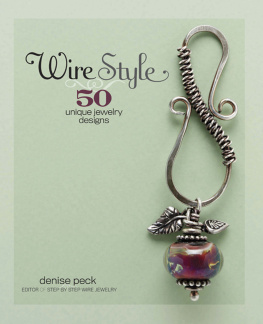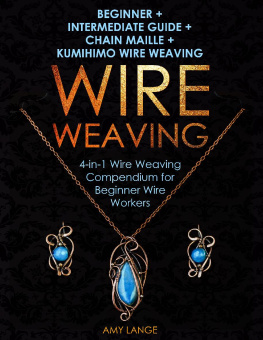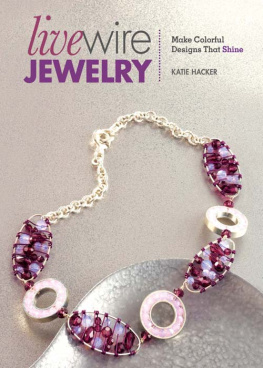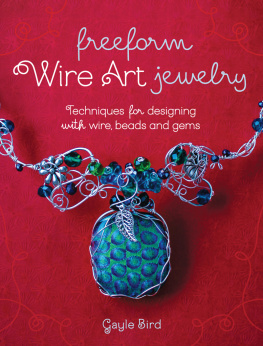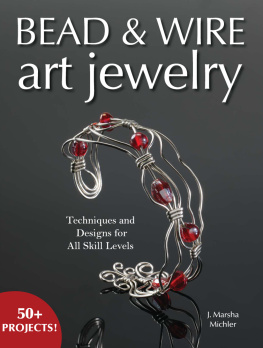
Wire Style

denise peck
EDITOR OF STEP BY STEP WIRE JEWELRY

project photography joe coca
process photography jim lawson
art direction & cover design pamela norman
interior design stacy ebright
Text 2008 Interweave Press LLC
Photography 2008 Interweave Press LLC
All rights reserved.

Interweave Press LLC
201 East Fourth Street
Loveland, CO 80537-5655 USA
Library of Congress Cataloging-in-Publication Data
Peck, Denise.
Wire style : 50 unique jewelry designs / Denise Peck, author.
p. cm.
Includes bibliographical references and index.
ISBN 978-1-59668-070-8 (pbk.)
ISBN 978-1-59668-906-0 (PDF)
ISBN 978-1-62033-192-7 (ePub)
1. Jewelry making. 2. Wire jewelry. I. Title.
TT212.P425 2008
739.27--dc22
2008003840
Acknowledgments
First and foremost, my sincerest thanks to the artists who have contributed their designs and tutorials to the pages of this book. The jewelry world is filled with the most talented and generous people Ive had the fortune to know. They never stop surprising me with their willingness to share their art.
Thanks to my colleagues, who make it a joy to come to work every day.
I am grateful to Linda Ligon and Tricia Waddell for believing from Day One that I should write a book.
And mostly, thanks to my husband, Paul, who has nothing but genuine and enthusiastic support for whatever endeavor I take on (not to mention the ability to fix whatever is ailing the computer).
Denise Peck
Contents
Denise Peck
Sandra Lupo
Kerry Bogert
Tamara L. Honaman
Ronna Sarvas Weltman
Jodi L. Bombardier
Tamara L. Honaman
Denise Peck
Howard Siegel
Linda Gettings
Tamara L. Honaman
Ronna Sarvas Weltman
Jodi L. Bombardier
Kerry Bogert
Sandra Lupo
Denise Peck
Tamara L. Honaman
Linda Gettings
Ronna Sarvas Weltman
Kerry Bogert
Jodi L. Bombardier
Tamara L. Honaman
Ronna Sarvas Weltman
Howard Siegel
Sandra Lupo
Howard Siegel
Denise Peck
Denise Peck
Jodi L. Bombardier
Linda Gettings
Kerry Bogert
Ronna Sarvas Weltman
Denise Peck
Sandra Lupo
Jodi L. Bombardier
Ronna Sarvas Weltman
Howard Siegel
Linda Gettings
Tamara L. Honaman
Kerry Bogert
Jodi L. Bombardier
Ronna Sarvas Weltman
Denise Peck
Denise Peck
Kerry Bogert
Linda Gettings
Denise Peck
Jodi L. Bombardier
Denise Peck
Ronna Sarvas Weltman




F rom the simplest to the most elaboratethat is the beauty of designing jewelry with wire. You can make a wedding band of a single ring of wire or a tiara ablaze with jewels. There is hardly a piece of jewelry that isnt made with some wire. Think about it: Every chain you see starts with wire. Every pierced earring has a post or hook made with wire. Every pin must have a pointed piece of wire to pierce your clothing. Wire is by far the most important element in the art of jewelry making.
It is also the most versatile. You can make designs in wire that are elegant, lush, lyrical, whimsical, austere, or even primitive. Designs can be evocative or literal. The material itself is available in a variety of shapes and sizes. Its made of silver, gold, aluminum, steel, brass, copper, and niobium. You can hammer it, bend it, twist it, fold it, coil it, file it, heat it, and even color it. But heres the best part: If you can hold a pair of pliers, you can make jewelry out of wire!
Maybe youre a beader ready to add to your jewelry-making repertoire. Maybe you want to make jewelry but havent yet been lured by the magic of beads. Or maybe youve always wanted to be a metalsmith but were daunted by the time, space, and money required. Wire is the perfect answer. You can make wire jewelry with just a few very basic techniques. Every piece of jewelry in this book can be made using the techniques that are outlined and illustrated step by step in the first chapter. Youll also find a comprehensive reference guide for all the tools and materials you need for all the projects, plus a few more for when youre ready to expand your workshop.

The projects that follow are fifty brand-new designs by eight experienced jewelry makers. There is a wide array of styles in a selection of metals and colorsa smorgasbord of designs chosen for their originality and technique. If you learn how to make the designs in this book, youll be able to make just about any piece of wire jewelry you desire. I hope this book not only introduces you to the wonderful world of wire but also awakens the design spirit that exists deep down in all of us jewelry lovers!

One of the best things about working with wire is that its such a forgiving medium. If you make a mistake, you can often restraighten the wire and begin again. Additionally, you can buy practice wire very inexpensively and create with impunity! Copper, brass, and colored craft wire are available in hardware and craft stores, and all of them can produce finished pieces every bit as beautiful as sterling silver and gold.
W ire comes in a large variety of metals, shapes, and sizes. The size or diameter of wire is known as the gauge. In the United States, the standard is Brown & Sharpe, also known as American Wire Gauge (AWG). The diameter of wire in inches or millimeters is translated into a numeral from 0 to 34, the higher the number, the thinner the wire. Most of the projects in this book use wire in 14-gauge through 24-gauge.
Wire also comes in a variety of shapes. You can buy round, half-round, and square wire. Round is most commonly used and easily available. Half-round has a flat side and is commonly used for ring shanks, and square wire has four flat sides. Both half-round and square wire must be ordered from a jewelers supplier. In most cases, the choice of shape is purely aesthetic.
Additionally, a jewelers supplier will offer wire in three hardnesses: dead soft, half hard, and full hard. Dead-soft wire is best if youre going to be manipulating it a lot because wire work-hardens as you work with it. Work-hardening stiffens the wire and makes it harder to bend. Eventually it can become so brittle that it can break with additional manipulation.
Next page
